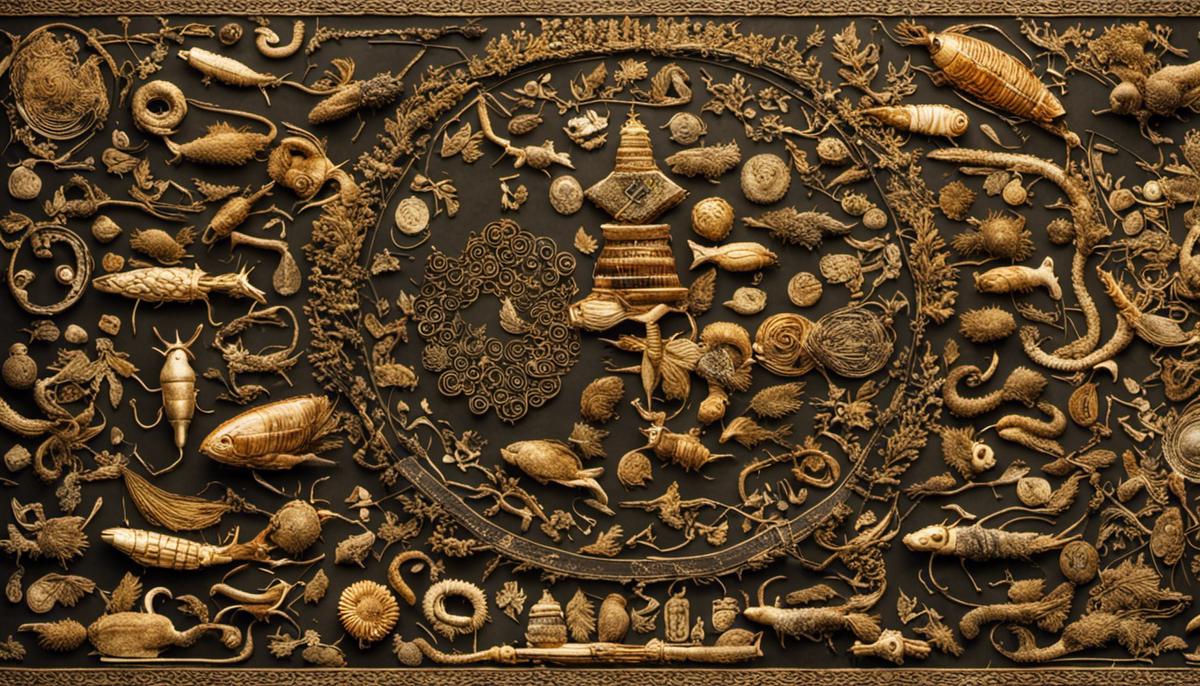The enigma of dreams and their interpretation has captivated the human mind for centuries. While scientifically linked to our subconscious thoughts and experiences, they’re also seen as windows providing insight into our spiritual and psychological state. One image that frequently manifests itself in dreams with a significant impact is the maggot. A symbol eliciting revulsion and discomfort in many cultures, maggots have a profound place in biblical scriptures, influencing their interpretation in dreams. In the Bible, maggots have been associated with punishment, decay, and mortality. By juxtaposing this biblical view with other cultural and religious interpretations, and contemporary dream analysis methodologies, we can broaden our understanding of the significance of dreaming about maggots.
Theological Interpretation of Maggots in the Bible
Title: An Inquiry into the Biblical Contexts and Interpretations of Maggots
The study of theological interpretation, especially within the realm of religious symbols and metaphors, is saturated with challenging perspicuity and complexity. A compelling example is found in the depiction of maggots in biblical literature. The scope of this discussion seeks to delve into the multifaceted representations of maggots in biblical contexts and how these interpretations have transformed over the centuries.
Biblically, an immediate connection is established between decay, mortality, and maggots, and they stand as metaphorical symbols embodying both physical and moral deterioration. This concept is evident in various biblical narratives and allegorical illustrations. In the Book of Exodus (Exodus 16:19-20), maggots serve as a divine warning against hoarding the manna from heaven, indicating a corruption of trust and faith. Hence, the maggots’ appearance represents a moral decay corresponding to a faithless, disobedient attitude. Thus, it can be stated that a foundational understanding of maggots as a metaphor is associated with the divine retribution on disobedience and mistrust.
The Book of Job presents a profound association between maggots, human mortality and transience, thereby projecting a theologically somber perspective on human life. Job (Job 7:5; 17:14; and 21:26) extensively allegorizes himself as embracing maggots and dust, reinforcing the symbolism of maggots as agents of decay and ultimate mortality. This prevalent literary device manifested within the narrative acts to underline the transient, perishable nature of human life, and the eventual trajectory toward decomposition.
Delving further into post-biblical interpretations, the maggot metaphor extended its reach into themes embodying spiritual depravity and moral corruption. Christian eschatology, in particular, depicts maggots as part of divine punishment afflicting the damned in Gehenna, symbolizing eternal decomposition (Mark 9:48).
From an ecological perspective, maggots and similar detritivores were recognized for their role in waste degradation and nutrient cycling in later medieval theology. Their portrayal in the Bible appears to represent divine wisdom and providence, elucidating an efficient system for organic matter decomposition and recycling.
Hence, a compelling examination of the biblical depictions of maggots denotes a spectrum of thematic interpretations. Initially interpreted as symbols of physical decay and moral decline, these creatures eventually segue into representations of human mortality and spiritual decomposition. The metamorphic narrative arch of this metaphor is as intriguing as the creatures themselves.
However, such studies require deeper contemplation, rigorous critical analysis, and contextual understanding of the linguistic, sociocultural, and theological aspects that thread their way through the biblical texts. By appreciating maggots within this biblical context, readers could explore the manifold interpretations and implications that these seemingly insignificant creatures hold, thereby enriching our understanding of life, morality, spirituality, and the divine within the vast, intricate web of biblical literature and theology.

Dream Theories in the Biblical Context
Title: Dream Interpretation in Biblical Scholarship: A Deeper Look
One of the captivating aspects of biblical scholarship pertains to the interpretation of dreams. The Bible, a text steeped in symbolic imagery, opens an intriguing discourse on the realm of subconscious visions. Merely terming them as ‘dreams,’ one might argue, somewhat undersells their profound significance within the biblical narrative.
Dream interpretation is not a negligible facet of biblical studies. It forms the bedrock of many pivotal moments in the Bible and presents a generous conduit for understanding the complex metaphysical philosophy encapsulated in the Holy Book.
Biblical scholars have adopted a variety of approaches pertaining to the interpretation of dreams. Notably, the Bible provides multiple instances of dreams used as divine conduits. These ethereal visions gave precognition of significant events or delivered divine messages, evident in the dreams of significant figures like Jacob, Joseph, and Pharaoh.
Equally important is the acknowledgement of cultural contexts. The ancient Near East, in which much of the Bible was written, held a strong belief in dreams as prophecies and direct messages from the deities. Biblical scholars acknowledge this cultural ethos intrinsically linked to dreams, presenting a heightened understanding of the dream narratives encapsulated in the Bible.
Contextualizing dreams in the biblical narrative also demands an understanding of the Hebrew thought patterns and Its connection to the ancient Semitic mindset. The Hebraic culture, scholars argue, perceived dreams as divine communications but also acknowledged the possibility of meaningless dreams. This dichotomy offers an intriguing academic avenue – examining dream narratives in the Bible within this broad spectrum of divine prophecy and frivolity.
Moreover, the awareness of the dichotomous nature of dream narratives precedes a critical reading of the Bible. For instance, interpreting dreams involving prophetic elements not only uncovers divine revelations but also brings forth human emotional responses. The interplay of fear, awe, or relief defines the reaction to the dream and subsequently, the narrative course.
Biblical scholars also delve into the symbolic expressions employed in dreams. The dream symbols often carried metaphorical significance – wheat sheaves, stars, or animals held certain connotations within the ancient cultures which, when decoded, unfurl profound meanings within the biblical narrative.
In gauging the biblical interpretation of dreams, the necessity of historical criticism can not be overlooked. Scholars employ historical criticism to identify the historical context of the dream narrative. This method facilitates a clearer understanding of the dramatic significance of dream interpretations within the Bible.
To surmise, biblical scholars’ perspective on dream interpretation is not monolithic. It is multidimensional, dynamic, and profoundly imbued with cultural, historical, and theological undertones. This very complexity renders dream interpretation a riveting and enriching pursuit in biblical scholarship – an intellectual journey unravelling the layered depths of the Holy Book.

Symbolism of Maggots in Cultural and Religious Mythologies
Moving beyond the biblical context, it is equally enlightening to explore how maggots are symbolic in other cultural and religious mythologies. Across varying cultures and time periods, maggots connect themes of life, death, and transcendence, offering a fertile ground for critical exploration and analysis.
In Norse mythology, for instance, maggots play a substantial role. They emerged from the body of Ymir, the first being, and were recognized as the dwarves. This mythology underscores maggots as a symbol of primordial life and something born from decay.
In comparative Parasitic Wasp folklore, certain tribes perceive maggots as transformative creatures. Owing to their unique life cycle, they represent a form of rebirth or renewal after death. The parasitic wasp, which lays its eggs in the larvae of another insect, closely influences this belief. While this may appear grim to some, this metamorphosis is deemed sacred, encapsulating the cycle of life, death, and rebirth.
Discussing maggots in the realm of Buddhism draws attention to the principle of impermanence. In various Buddhist teachings, the image of a corpse infested with maggots serves to reflect the inescapable truth of mortality. In traditional meditation techniques, practitioners are encouraged to meditate on the image of a rotting body, underlining the transient nature of life and the inevitability of decay.
Witchcraft and occult practices also expose an avenue for comprehending the symbolic nuances associated with maggots. Traditionally, they are used as divination tools to uncover hidden truths, playing a part in rituals designed to draw out specific outcomes. Herein, the maggot serves as a profound symbol of revelation, divulging the unseen aspects of reality.
Ancient Egyptian iconography presents various depictions of the Scarab Beetle, a close relative of the maggot as they both belong to Diptera order in their youth. This creature was revered because Egyptians equated its behavior of rolling and burying dung balls to the daily movement of the sun across the sky. Consequently, the Scarab came to symbolize creation, resurrection, and the cyclical nature of the cosmos.
In conclusion, while the maggot carries undertones of decay, death, and retribution in biblical contexts, it manifests starkly diverse symbolic portrayals across different cultural and religious mythologies. From the emblems of life’s cyclical nature to principles of impermanence and mysterious revelatory faculties, the academic exploration of maggots as symbolic elements extends far and wide, underpinning the complexity and depth of human perceptions and beliefs.

Modern Dream Interpretation Methodologies
Turning to the intriguing topic of dream interpretation with respect to maggots, contemporary scholars assemble a collection of systematic approaches to explore this vibrant aspect of biblical symbolism. An excellent starting point is the application of psychoanalytic theories, notably those expounded by Carl Jung. Recognizing dreams as conduits of divine revelation, Jungian interpretations foreground the role of archetypal symbols, which chess may accord a richer understanding of a maggot’s representation in dreams.
Equally notable is the application of cognitive anthropology, a twenty-first-century discipline that combines psychology and anthropology to offer insights into how cultural factors influence biblical interpretations of dreams. A cognitive anthropological approach to dream interpretation would consider maggots in dreams as aspects of cultural cognition deeply embedded within the biblical text and context.
Not to be overlooked is the growing domain of neurotheological interpretations of dreams. Neurotheology, or the study of neural correlates of religious and spiritual experiences, provides a biopsychosocial lens to interpret maggots in dreams. Scholars might explore how altered states of consciousness, triggered by dreaming, influence the biblical interpretation of maggots.
Bracketing these modern approaches is the recourse to intertextual analysis. The technique allows scholars to investigate links between texts with depicted maggots in dreams and other religious or cultural manuscripts. Such links then provide a deeper insight into the biblical symbolism of maggots. For example, an intertextual analysis might compare biblical interpretations of maggots in dreams with their representation in Norse mythology, parasitic wasp folklore, Buddhism, witchcraft, and even ancient Egyptian iconography—an avenue of research furthering a collective understanding of the nuanced symbolism of maggots in dreams.
Finally, scholars hinge on hermeneutics, or the art and science of interpretation, to strategically unpack metaphors and symbols in biblical texts. Hermeneutic analysis emphasizes context and the reflexive dialogue between reader and text as crucial to accurate interpretation. Employing this method, scholars discern the spiritual, ethical, and social implications of maggots in dreams as depicted in biblical narratives.
While there is an immense range of modern tools available to biblical scholars today, it is important to note their use is largely guided by the researcher’s philosophical and theoretical assumptions—underscoring the importance of critical reflexivity in biblical research. In this way, the process of interpreting biblical symbolism becomes as individual as the scholar themself, promoting a broad diversity of thought and analysis within the academic field. While this can lead to disparate views, it also encourages dynamic and ongoing dialogue, which is both the lifeblood and the joy of academic and scientific research.

Case Studies: Analyzing Dreams About Maggots
An Analysis of Individuals Dreaming About Maggots: A Multidisciplinary Cross-Analysis
The psychoanalytical perspective, notably championed by the influential likes of Sigmund Freud and Carl Jung, offers one possible interpretation when examining cases of individuals dreaming of maggots. Freud suggested dreams carry repressed desires, while Jung postulated the presence of universal symbols—archetypes—in dreams that suffuse across cultures and individuals. Therefore, such an interpretation may present maggots as symbolic agents of repressed fears, potential transformations, or under-acknowledged aspects of the dreamer’s psyche.
In the realm of cognitive anthropology, a discipline that examines cognitive processes within socio-cultural contexts, dreams represent a confluence of individual cognitive processes and cultural influences. Consequently, dreaming about maggots might imply a cognitive adaptation to societal notions about maggots connected with decay or taboo. This tension between societal conceptions and individual perceptions could lead to notable dream elements.
The emergent field of neurotheology, or spiritual neuroscience, provides a multidimensional lens. Drawing upon neuroscience, psychology, and religious studies, neurotheology explores neurophysiological correlations to spiritual encounters or mystic experiences. This field may posit dreaming of maggots as potential indicators of nerve cell activity patterns within brain regions like the amygdala or hippocampus, places primarily responsible for managing emotions and memory.
Further interpretations merging biblical depictions of maggots, dreams, and a move towards interdisciplinary understanding are possible. An intertextual analysis forms connections between biblical texts presenting maggots and those recounting dreams – a somewhat unexplored domain ripe for scholarly exploration.
Hermeneutics—the theory and methodology of text interpretation—offers an alternative approach. The constant interplay of understanding between the reader, text, and the context requires a flexible and reflexive dialogue. Hermeneutics might suggest the dreamer is engaging in an internal dialogue touching on foundational spiritual or ethical questions by dreaming of a maggot, a creature symbolizing both decay and the life’s essential recycling process.
Lastly, a growing emphasis on reflexivity in biblical scholarship encourages a critical analysis of one’s own biases and predispositions towards a text. This ethos promotes prudential authenticity over objective certitude, a reminder that interpretation is also a deeply personal venture. The discovered meanings reflect more about the interpreter’s personal narrative than the text itself—a reality scholars ought to acknowledge.
Unraveling the complexities and multilayered meanings of maggot-related dreams requires a combined effort of distinct academic disciplines. A united pursuit promises not just an innovative insight into the realms of dreams and spirituality, but also underscores the need for open dialogue, constant curiosity, and respectful conversation within the academic fraternity. The shared quest for understanding accentuates the beautiful diversity of thought characteristic of the academic sphere, an environment teeming with lively debates, dynamic ideation, and intellectual camaraderie.
Unquestionably, the arena of dreaming about maggots may initially seem disconcerting or taboo to some. Still, it potentially offers a rich source of inquiry that can provide profound insights into human cognition, cultural dynamics, spiritual experience and perhaps, the very essence of existence.

Photo by yoal_desurmont on Unsplash
Through examining theological interpretations, cultural mythologies, and modern dream methodologies, the significance of maggots in dreams has been substantiated and contextualized. Whether interpreted as harbingers of decay and mortality in biblical scriptures, or as representations of transformation and renewal in certain cultures, maggots in dreams undoubtedly carry significant implications. The use of real-life dream case studies enforces this, illustrating that maggots connect the dreamer to deep-seated feelings and experiences which require acknowledgment and understanding. Our continuous endeavor to decipher dream symbolism, including those involving maggots, is reflective of our innate human curiosity – an exploration that unveils inconspicuous facets of our psyche and spirituality.







